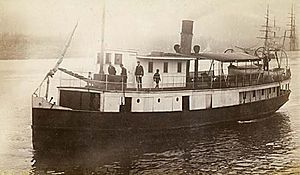- Comox (steamboat)
-
For other uses, see Comox (disambiguation).

Comox circa 1892.Career Name: Comox Route: coastal British Columbia Builder: Henry Darling In service: 1891 Out of service: 1920 Identification: Canada registry #100202 Fate: Transferred to Panama General characteristics Type: coastal steamship Tonnage: 101 gross tons Length: 101 ft (31 m) Beam: 18 ft (5 m) Depth: 5 ft (2 m) depth of hold Installed power: double expansion steam engine, coal-fired boiler. Sail plan: auxiliary sloop Speed: 11 miles per hour Capacity: 200 passengers Comox was a steamship built in 1891 in British Columbia which served until 1920. Comox was the first steel ship built on the west coast north of San Francisco.
Contents
Design and construction
Comox was built in 1891. The components of the vessel were manufactured in Paisley, Scotland and then shipped to Vancouver, British Columbia where they were assembled by Henry Darling. When complete, Comox was 101 feet long, with a beam of 18 feet and 5-foot depth of hold. Overall size of the vessel was 101 gross tons. The hull was steel, and Comox was the first steel ship built on the west coast north of San Francisco.[1][2] As built, Comox could accommodate almost 200 passengers.[3][4]
The power plant was a double-expansion steam engine, manufactured by Bow McLachlan & Co., Glasgow, Scotland. The engines had a high pressure cylinder 12 inches in diameter, low pressure of 24-inch diameter, and a stoke of 18 inches, and drove the ship at 11 miles per hour. Coal consumption was 4.5 tons in 24 hours.[3][4]
Comox had an auxiliary sailing rig as a sloop.[4]
Operation
Comox was completed in October 1891.[1] After completion, Comox was placed on routes running north from Vancouver.[4] Christ Dragoylovich (b.1857), a native of Austria, was the vessel's chief engineer.[5] Comox ran to logging camps on week days, and was used for excursions on weekends.[1] By 1909, Comox had made 2,000 trips out of Vancouver harbor.[2]
Disposition
Comox was sold for scrap in 1919, but was not dismantled. Instead, the vessel was sold to Panama interests and transferred south, under the name Alejandro.
Notes
- ^ a b c Steveston Museum, Richmond, BC (accessed 06-18-11).
- ^ a b Newell, ed., McCurdy Marine History, at page 156.
- ^ a b The New Mills' List, “Registered Canadian Steamships 1817-1930 over 75 feet” (accessed 06-17-11).
- ^ a b c d Wright, ed., Lewis and Dryden Marine History, at page 391.
- ^ Wright, ed.m Lewis and Dryden Marine History, at page 467.
References
- Newell, Gordon R., H.W. McCurdy Marine History of the Pacific Northwest, Superior Publishing, Seattle WA (1966).
- Wright, E.W., ed. Lewis and Dryden Marine History of the Pacific Northwest, Lewis & Dryden Publishing, Portland OR (1895) at page 467 (accessed 06-18-11).
Further reading
- Rushton, Gerald A., Whistle up the Inlet – The Union Steamship Story, J.J. Douglas (1974).
- 1891 ships
- Steamships of Canada
- Union Steamship Company of BC
Wikimedia Foundation. 2010.
